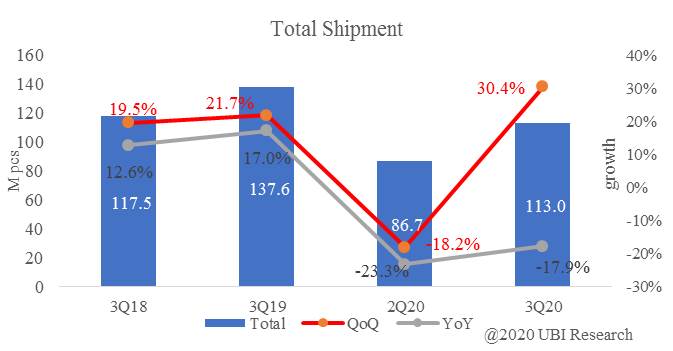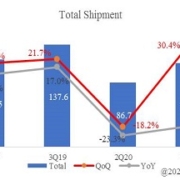OLED Market Enters Adjustment Period from Rapid Growth
As smartphone makers, including Samsung Electronics and Apple, increased the use of OLEDs in flagship models, the growth of the OLED market, which had been rapidly growing, has been braked.
The third quarter of each year is the season with the best OLED performance for smartphones due to the launch of a new iPhone. According to the display market track of UBI Research (www.ubiresearch.com), in the third quarter of this year, 113 million units were shipped, an increase of 26.3 million units compared to 86.7 million units in the last quarter, showing a growth of 30.4%. However, this figure is due to an optical illusion. The reason is that the results in the first and second quarters were very poor compared to before due to COVID-19. Compared to the third quarter of last year, shipments in the third quarter of this year decreased by 17.9%. Shipments are smaller than in the third quarter of 2018.

The decrease in OLED shipments for smartphones in the third quarter is due to the addition of Huawei sanctions to COVID-19. The sharp drop in shipments from Samsung Display and BOE to Huawei deteriorated the third quarter earnings.
There are also many analyzes that companies such as Samsung Electronics, Oppo, and Vivo will benefit from the reflection due to Huawei sanctions. However, since Samsung Electronics is currently struggling in the Chinese market, and the brand power of Oppo and Vivo is less than that of Huawei, it will be difficult to replace the expensive smartphone market in China occupied by Huawei. Therefore, Huawei’s smartphones, which mainly use OLEDs, disappear from the market, and shipments of Samsung Display and BOE are also forced to decrease more than expected.
The growth of the smartphone OLED market is expected to slow for the time being due to Huawei’s smartphone production disruption, which was expected to break through the 300 million units’ market and purchase OLED in large quantities. As a result, the OLED market in China will suffer a severe oversupply situation.



